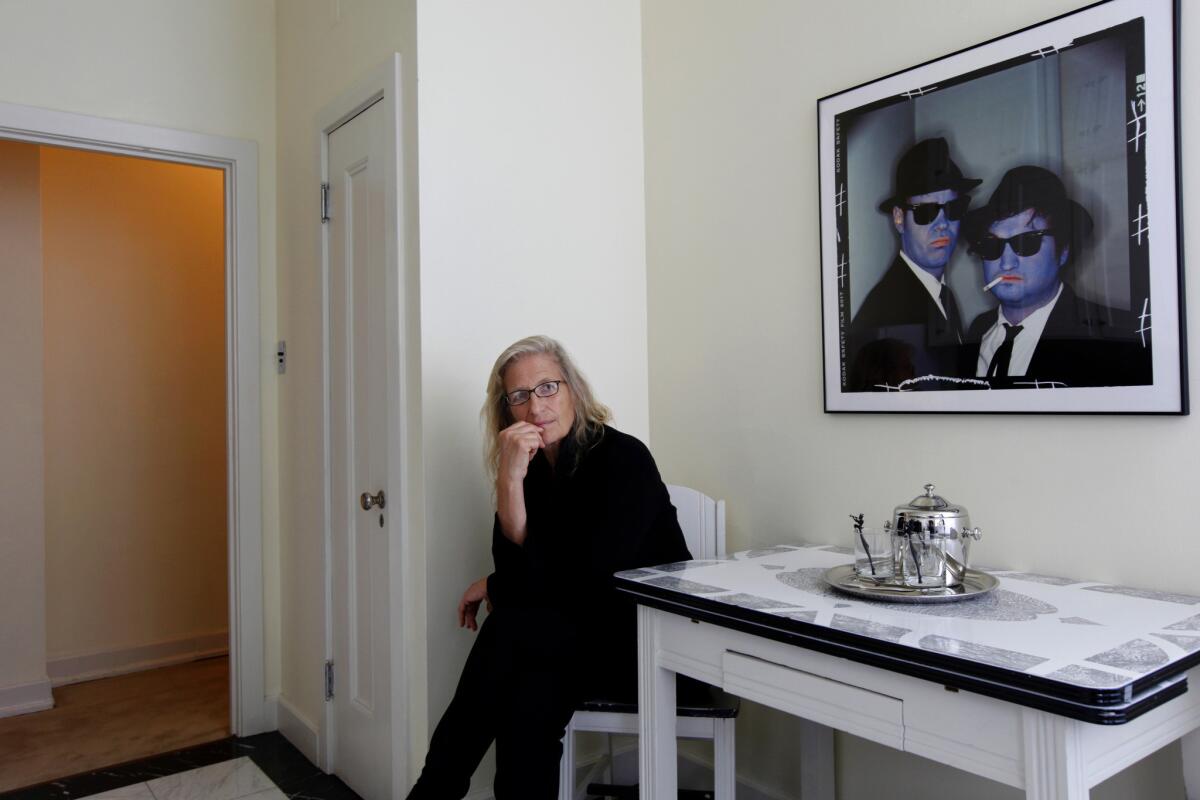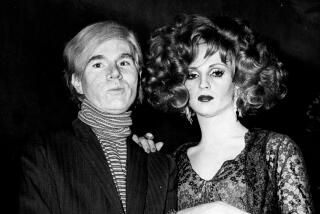Annie Leibovitz talks Taschen book, Miley Cyrus, John & Yoko

During four decades, Annie Leibovitz has been a dominant force in portrait photography, first at Rolling Stone and then with increasing skill and vision at Vanity Fair and Vogue. At 64, Leibovitz works hard at it still and isn’t ready for a broad career retrospective but takes a look back at some of her most lasting images in “Annie Leibovitz,” a huge limited-edition book from Taschen. In the tradition of Helmut Newton’s “SUMO,” the new volume is about 20-by-27 inches and 476 pages deep. It sells for $2,500 and comes with its own table, but the true richness can be found in the pictures, from Queen Elizabeth to R2-D2, from “The Sopranos” cast arranged like “The Last Supper” to her most famous image: Yoko Ono and a nude John Lennon embracing on their floor only hours before he was killed in 1980. She was interviewed at the Chateau Marmont.
The pictures in this book are big enough to hang in a gallery.
You could never hold it in your lap and thumb through it. The book comes with a stand. What I assume people will do is change the picture now and then. It is so big that by the time you get to the middle, you can’t remember where it started. It’s not a book. It’s really an installation, a piece of art.
PHOTOS: Celebrities by The Times
This book is a kind of retrospective.
It’s more like a ride. There are some of the more famous pictures in here because they look good big. John and Yoko look good big. Keith Haring looks good big. Whoopi Goldberg looked good big. But the book doesn’t have any fashion. It doesn’t have any politics. I have a little ways to go before I do a retrospective, and I was very clear with Taschen that I was game to do the book and intrigued by it, but it was going to be a potpourri. What’s interesting is to go back now and look through my work — if you’ve been doing something for 44 years, it’s so big. There’s more stuff there than I know.
What is the difference between a great photography book and just a collection of pictures?
You have to tell a story. What I counted on in all my books so far is that it’s usually a very personal point of view. Which is why I gave up on being a journalist — I thought having a point a view was more important than being objective. That’s what creates a really great book. Don’t let so much time pass before doing a book. It’s hard. It’s like sitting in a room with ghosts. You go through your pictures and you think about what that shoot was like, who that person was, what that meant, that time in your own life. It’s not so different from family pictures. You go through these emotions.
Your picture of John and Yoko carries a lot of weight.
It chokes me up just thinking about it. I had gone home after we took the pictures and it went very well. I was supposed to meet John and Yoko at the recording studio and I didn’t go. Jann [Wenner] called me at home and said that John was taken into Roosevelt Hospital. I went over and waited there with the press. That was a very strange moment in my life. You sort of realize you’re in this position where you’re taking these pictures. The whole story changes after he dies. It turns into a different picture.
CRITICS’ PICKS: What to watch, where to go, what to eat
Some people you’ve photographed over and over again.
That’s the best thing. You build a relationship. Even the John and Yoko picture is a really good example, as I’d photographed them 10 years earlier. And when we did that session, I had done another session with him two weeks before and gone back to the apartment. Those are the best if you can go there a couple of times.
Does it affect the pictures that you’re a well-known photographer and people actually want to be photographed by you?
It works the other way too — people who don’t want to be photographed by someone well known. They feel like there’s more pressure on them. The reality is you’re working with people who are pretty professional, want to do their best. You’re working together and you both want to do something good. There’s no other agenda.
Are movie actors good as subjects?
A lot of the very best actors are very uncomfortable having their picture taken because there’s not a role for them. That’s why my early work became more conceptual. Meryl Streep was very unhappy about having her photograph taken. I said, “Do you want to put on this whiteface [makeup]?” and then it just exploded. You set a stage and you want them to perform and project. No one wants to be themselves.
PHOTOS: 50 most beautiful female celebrities
In the book is your 2008 Miley Cyrus picture for Vanity Fair, which caused some controversy.
When I met her you could tell she was on the verge. She was a girl becoming a woman. We took those pictures and I thought she looked so beautiful and having a little bit of an edge to her. She loved doing the pictures, and she was made to feel bad for doing them.
In the last decade, your work has included very raw Polaroid pictures but also portraits with digital post-production.
Very much like everyone else, I’m using what’s out there now and learning how to use it. Like everyone else, I sometimes go too far and I try to bring it back. The best thing is to make it as simple as possible. Obviously, there’s more to play with, and we’re all trying to figure out how to use it and what to do with it. I’m definitely on a learning curve right now. There’s a little too much hanky panky with this stuff and I want to try and bring it back. It’s very seductive.
More to Read
The biggest entertainment stories
Get our big stories about Hollywood, film, television, music, arts, culture and more right in your inbox as soon as they publish.
You may occasionally receive promotional content from the Los Angeles Times.







